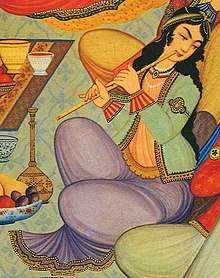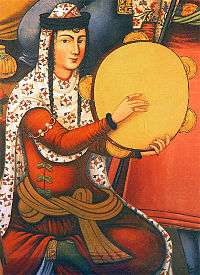Balaban (instrument)
Balaban, or balaman[7] (Azerbaijani: Balaban) is cylindrical-bore, double-reed wind instrument about 35 centimetres (14 in) long with eight finger holes and one thumb hole. Balaban, one of the ancient wind instruments, is played in all corners of Azerbaijan. This instrument is played in Iranian Azerbaijan and in the Republic of Azerbaijan.
| Classification | Woodwind |
|---|---|
| Playing range | |
 | |
| Musicians | |
| Alihan Samedov | |
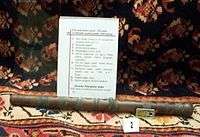
Balaban can be made of mulberry or other harder woods, such as walnut. The bore through the instrument is about 1.5 centimetres (0.59 in) in diameter. The double reed is made out of a single tube of cane about six cm long and pressed flat at one end. The performer uses air stored in his cheeks to keep playing the balaban while he inhales air into his lungs. This “circular” breathing technique is commonly used with all the double-reed instruments in the Middle East.
Balaban can be found in many regions of Azerbaijan and Anatolia. It is sometimes used in Balaman, Mey or Whistle, Azerbaijan and Turkistan in the West Azerbaijan region.
Consisting of a body (govda) and a mouth-worn flat reed mouthpiece, Balaban is 280-300 millimeters long and 20-22 millimeters in diameter. The sound is dull and light, and because it is weak, it is mostly played in closed spaces and room meetings. Thanks to the clamp on the reed, the sound can be thinned and thickened. The cane, flattened by a special method, consists of a clamp and a body. By pushing the grapple upwards or downwards on the reed, one-curtain sound change can be made and it can adapt to the instrument groups immediately. According to Azerbaijani artist Hüseynqulu Sarabski, hunters steal balans and attract quails. Another type of Balaban is used in love music. Alihan Samedov is a famous Azerbaijani ballaban artist.
Structure
Balaban, which is often called also yasti (flat) balaban for flat mouthpiece and soft sound, consists of body made of apricot tree, cane, barrow and cover. The body has 8 holes on the surface and 1 on the back in the middle of the first and second holes (sound fret) on the surface.[8] It consists of a stem, a reed, a regulator, and a cap.[9]
The stem of the balaban, or govda, is a 280–320 millimetres (11–13 in) cylindrical tube made primarily of apricot wood (sometimes hazel, pear, mulberry, boxwood, etc.). The process of carving a balaban stem is called balaban chakma. The upper end of the stem (bash or kup) is given a round shape, whereas the lower end (ayag) is sharpened. The bore is 10 millimetres (0.39 in) in diameter. Eight holes or "tones" constituting a "sound tone" (sas pardasi) are made on the obverse and another one is made on the bottom side, opposite of the interval between the first and the second holes of the sas pardasi. Sometimes an additional hole called nizam pardasi is made on the lower end of the bottom side to ensure good timbre.[9]
The holes made on the stem are classified as follows:[9]
| Sound tone– sas pardasi | Functional | #1 – first tone– bash parda |
| #4 – main tone – shah parda | ||
| #6 – open tone– achyg parda | ||
| #8 – bottom tone– ayag parda | ||
| rear – back tone– arkha parda | ||
| Tonal | #2 – tone of segah – segah pardasi (1) | |
| #5 – tone of segah – segah pardasi (2) | ||
| #7 – tone of mahur – mahur pardasi | ||
| Acoustic | bottom – tone of balance – nizam pardasi | |
The reed (gamish, garghy or dil) made of club-rush that grows in an arid area is inserted into the upper end. It flattens and takes the shape of a double reed. It is tied to a 60 millimetres (2.4 in) long and 10 millimetres (0.39 in) wide regulator (kharak, boghazlig, boyundurug, ulama, akma) made of a willow or grape branch cut lengthways. The reed is then fixed by a collar-like regulator on one side and a 7–12 millimetres (0.28–0.47 in) pivot on the other side. The cap (qapaq, aghizlig, kip, band, etc.) made of willow, hazel, cornel or mulberry is put on the reed to prevent it from damage. It is tied to the regulator in order not to be lost.[9]
History
In the region; Balaman is also called Yasla Balaman, flat Balaman.
- Balaman in Black Hearts.
Its old Turkish name is "Nerme ney". (Ner male means, we will talk about this again.) Balaban first used in Azerbaijan orchestra since 1931, when the Folk Instrument Orchestra was established in Azerbaijan. It is used to accompany songs in Turkmen and Kurdish cities such as Erbil, Süleymaniye, Kirkuk. Balaban, which has a warm sonority, is often used as a companion to the songs of heaven and bendir and Aşık. Kudüm and defle can also perform a duet, and are also performed solo. 2 The balaban plays together, while someone gives a sound, and someone plays the melody. yes
Use
On solemn occasions such as weddings and holiday ceremonies, a balaban-player is accompanied by a percussionist. A traditional Azeri musical group consisting of two balaban-players and a percussionist is called balabanchilar dastasi. The short selection of Azerbaijani mugham played in balaban, national wind instrument was included on the Voyager Golden Record, attached to the Voyager spacecraft as representing world music, included among many cultural achievements of humanity.[10] It was also used in pastoral songs and funeral music. According to Huseyngulu Sarabski, hunters played the balaban to attract quails. Certain types of the balaban are also used in ashik music.[9]
Legacy
Kamil Jalilov's recording of the song with balaban was included on the Voyager Golden Record, attached to the Voyager spacecraft as representing mugham, only Azerbaijani song included among many cultural achievements of humanity.[11][12][13][14]
Gallery
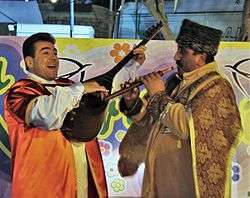 Ashuq plays balaban in Baku
Ashuq plays balaban in Baku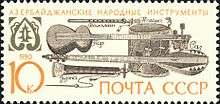 Azerbaijani musical instruments (including balaban) on the stamp of USSR, 1990
Azerbaijani musical instruments (including balaban) on the stamp of USSR, 1990
References
- "Толковый словарь русского языка Кузнецова. 1 е изд е: СПб.: Норинт. С. А. Кузнецов". Archived from the original on 2012-07-09. Retrieved 2012-07-18.
- Музыкальная энциклопедия. Азербайджанская музыка. Под ред. Ю. В. Келдыш. Т 1. А — М.: Советская энциклопедия, 1973.
- Меджнун Керимов. Атлас традиционной азербайджанской музыки. Бабалан
- Известия. Ру: «Имеющий уши да услышит…»
- Сергей Александрович Токарев. Основы этнографии: Учеб. пособие для ист. специальностей вузов.. — Высшая школа, 1968. — С. 311. — 359 с.
- Encyclopaedia Iranica. Balaban.: «BĀLĀBĀN, a cylindrical-bore, double-reed wind instrument about 35cm long with seven finger holes and one thumb hole.It is played in eastern Azerbaijan in Iran and Soviet Azerbaijan (where it is also called düdük).»
- Музыкальная энциклопедия. Баламан. Под ред. Ю. В. Келдыш. Т 1. А — М.: Советская энциклопедия, 1973.
- Ch, R. A. M.; 51, Rakausika राम च (2012-11-18). "The Music Of Azerbaijan". A World,s Heritage Of Native Music. Retrieved 2017-05-16.CS1 maint: numeric names: authors list (link)
- Charming Sounds of the Balaban Archived 2018-08-11 at the Wayback Machine by Saadat Abdullayeva
- Ch, R. A. M.; 51, Rakausika राम च (2013-03-05). "مقام The Music Of Azerbaijan Vol-02 مقام". A World,s Heritage Of Native Music. Retrieved 2017-05-16.CS1 maint: numeric names: authors list (link)
- "AZƏRBAYCANDA BALABAN SƏNƏTİNİ ÖYRƏNƏN AMERİKALININ İNDİ 80 TƏLƏBƏSİ VAR (Balaban ustadı Babaxan Əmirovun dedikləri)". mediaforum.az (in Azerbaijani). Archived from the original on 2014-05-14. Retrieved 13 May 2014.
- Azerbaijani Music Selected for Voyager Spacecraft
- Azerbaijani mugham sent out to outer space 32 years ago
- "Voyager - Spacecraft - Golden Record - Sounds of Earth". NASA. Retrieved 2009-05-25.
External links
- Ch. Albright. BĀLĀBĀN. Iranica.
- https://www.muzikogretmenleriyiz.biz/mey-duduk-balaban/
- Balaban, Duduk and Mey (video)
.jpg)
